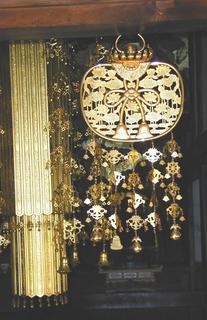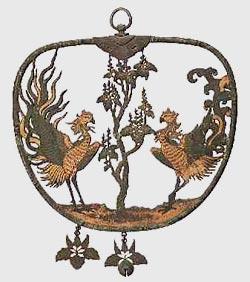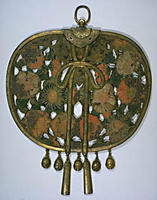:::::::::::::::::::::::::::::::::::::::::::::::::::::::::::::::::::::::::::::::::::::::::::::::::::::
Flower Garlands, Flower Hangers, keman 華鬘
Sanskrit: kusuma maalaa
Schmuckplatte, Blumengirlande, decorative discs, pendant discs

Origin
In India and other hot countries it was the cutom, to decorate the body of a guest with a flower garland. Statues of deities and highranking priests were also decorated in this way, so that the disciples could show their devotion. Only normal monks and nuns were not allowed to receive such a garland of living flowers as a present.
In the sects of esoteric Buddhism it is customary to decorate the body of the initiant for a priest with a flower garland to indicate, that from now on, he is in the ranks of the deities.
In esoteric Buddhism there is a special Bodhisattva for flower decorations, Keman Bosatsu, 華鬘菩薩.
Flower garlands are also placed on the head of a dead person, to help the departing soul find its way to the other shore. Thus a flower garland is also a symbol for rebirth.
Function
Since real flowers do not last long in hot countries, they were reproduced in lasting materials for decorative purposes in a temple and as flower offerings. They belong to the ritual decoration objects (shoogon 荘厳) of a temple.
The flower garlands are hung on a special beam (nageshi) in a special place in the inner sanctuary (naijin 内陣). Long after the introduction of these objects to Japan, they were also used in Shintoo Shrines.

Form
Most of the flower garlands are in the form of a Chinese hand-fan (uchiwa 団扇), some are round or oval. Since the end of the Haian period they are especially richly decorated.
Common patterns are Chinese arabesques and flower patterns, birds (karyoobingamon), Peonies and Lotus flowers, bird and flower patterns (kachoo 花鳥), angle-like maidens (apraras) or other religious motives.
On the top they have a hook of metal, which is usually decorated like a lotus blossom or a lotus leaf.
According to the form one can distinguish four types:
fretwork, form of a Chinese hand-fan, flower wreaths and pearl wreaths.
Material:
Wood, Jewels, seldom leather or woven material. Since the Heian period gilded bronze was often used.
Very fine silk gauze (ra keman 羅華鬘) was used in special situations, one of these pieces is still kept in the treasure storehouse of the Shoosoo-In 正倉院 of the temple Toodai-Ji in Nara.
Keman from material and thread (ito keman 糸華鬘, soshi keman ソシ華鬘) are known, also some of knotted thread (kumihimo keman 組みひも華鬘.
Keman with a replica of a real flower garland are called hana tsunagi-shiki keman 花つなぎ式華鬘. When pearls are used instead of flower motives, they are called tama tsunagi-shiki keman 玉つなぎ式華鬘, gyokushiki keman .
:::::::::::::::::::::::::::::::::::::::::::::::::::::::::::::::::::::::::::::::::::::::::::::::::::::
Let us look at some special types:
Flower decorations made of leather (gohi keman 牛皮華鬘)
They are usually in fretwork (sukashibori 透かし彫り)and covered with gold powder or color. Leather objects in a Buddhist temple are usually not seen, since it was now allowed to take the live of living beings and the killing of cows was forbidden.
Quote from the National Museum, Tokyo

These stylized garlands, made of leather, originally belonged to Kyôôgokoku-ji Temple, more commonly known as Tô-ji, in Kyoto. Today, thirteen ornaments remain, all of them fashioned in openwork leather, which were lacquered, primed with white clay, and then decorated with polychrome patterns. The thirteen can be roughly divided into two types based on their motifs. One type has two Kalavinkas (J. Karyôbinga, karyoobinga, paradisiacal birds with human heads) facing each other on a ground of hôsôge, imaginary Buddhist flowers, made to look like real flowers. The center shows a bow reminiscent of that which would have bound together fresh flowers. The Kalavinkas hold floral baskets containing blossoms to scatter on the buddhas and bodhisattvas in praise. In the other type, the bow is placed at the center with floral tendrils and arabesques (J. karakusa) covering the entire surface.
The thirteen pieces exhibit individual differences in style. Since there are at least three or four distinguishable styles in both garland types, it is difficult to believe that these ornaments originally formed one set. The superior stylistic treatment exhibited in Stylized Garlands numbers 7 and 8, seen in the use of the red lines on the bodies of the Kalavinka and the delicate cut gold leaf on the robes, reflects traditional techniques of Buddhist painting of the Heian period (794-1185). On the ornaments with only floral tendrils and arabesques, a gradation technique called ungen zaishiki (in which several shades of similar hue are closely brushed together) and delicate patterns of cut gold leaf were applied.
The iconography of two Kalavinkas facing each other on a ground of floral tendrils can also be found on the gilt-bronze openwork garlands of Chûson-ji Temple in Iwate Prefecture, which are presumed to date from the first half of the twelfth century. The resplendent examples in the Nara National Museum are thought to have preceded the Chûson-ji pieces. Although there is no record as to the hall in which the former garlands were used, they are believed to have been produced sometime in the eleventh century.
Look at more keman from leather:
http://www.emuseum.jp/cgi/pkihon.cgi?SyoID=7&ID=w008&SubID=s000&Link=
. - The Six Birds of Paradise - 浄土の鳥 - .
:::::::::::::::::::::::::::::::::::::::::::::::::::::::::::::::::::::::::::::::::::::::::::::::::::::
Flower Garland in the form of a Chinese Hand-fan (uchiwagata 団扇形)
Maybe the most famous of this type is preserved at the Temple Chuuson-Ji in Hiraizumi.

http://www.pref.iwate.jp/~hp0910/kore_naani/t/h/05.html
The outside is formed by a metal band (fukurin). In the middle is a thread with a decorative knot with two hangers (agemaki 総角). This is part of the motive of a real flower decoration, when the blossoms were threaded to keep in form. It reminds of the knots used in a Japanese samurai body armour.
On the bottom are small metal bells in form of dewdrops (rogata kanagu ろ型金具) and stripes (tansakugata kanagu たんさく型金具.
華鬘といえば金色堂のこの華鬘のかたちが思いおこされるほどに、わが国の平安時代を代表(だいひょう)する金工芸品です。金色堂にはこの華鬘と同じ作りのものが三面残されており、金色に光りかがやくお堂の中の中央壇(ちゅうおうだん)を飾ったものと伝えられています。今から八百数十年前に岩手に花開いた奥州平泉文化の華やかさを物語るものといえましょう。
http://www.pref.iwate.jp/~hp0910/kore_naani/t/h/05.html
In esoteric Buddhism, we also find this form with Sanskrit letters (seed syllables) in the middle (shuji keman 種子華鬘). The sylables are sometimes in a circle (ensoo) on a small lotus podest. Sometimes they were shown within a small pagoda.

http://www.narahaku.go.jp/meihin/kougei/116.html
:::::::::::::::::::::::::::::::::::::::::::::::::::::::::::::::::::::::::::::::::::::::::::::::::::::
Keman with cut-out patterns (saimonshiki keman 裁文式華鬘)
saimon is short for: saidan shita monyoo 裁断した文様)

From Kamakura, Hachimangu Shrine
Muromachi Period
本品は、神仏習合期の鶴岡八幡宮社殿内に奉献された荘厳具と思われ、寺院に伝来する華鬘とは、形式や意匠がやや異なる。竹幹状につくった縁を団扇状につくり、その内の中央に桐樹、その両面に対向する鳳凰を配した図様を木板を切透して表現し、木地に布を着せ、薄く黒漆を塗り、その上に群青、朱の色彩に金銀の箔を押した配色の極彩色である。
中央上部の釣金具は金銅製で宝相華唐草文を毛彫であらわし、下部には金銅板の瓔珞(ようらく)が付けられている。元来は3個あったものであろうが、現存は2個で、ともに桐文をかたちどるが中央は鈴になっている。
鳳凰は、古来中国で尊ばれた瑞鳥で、梧桐に宿り竹実を食べ醴泉を飲むといい、聖徳の天子の時に出現すると伝えられている。鳳凰に桐竹を配しているのは、この伝説に基づくのであろう。わが国でも古くから瑞祥文として、この意匠が好まれたと思われる。
http://www.hachimangu.or.jp/about/precious/c05_03.html
Usually in form of a fan or round. Motives can be flowers (hanagata saimon)、 phoenix birds (hoo-oo gata saimon 鳳凰型裁文) like the one above, or Sanskrit letters. The material is usually wood or gildes bronze.
...............................
With Chrysanthemum and Peony Motives
Made in 1389

岡山県・弘法寺(こうぼうじ)より伝来した木製彩色透彫りの華鬘。同寺には重要文化財に指定されている2面が伝えられ、当館に2面が所蔵されている。同寺伝存の納置用黒漆箱蓋裏に「花慢十二流」、身底に「千手山/備前国熊山霊仙寺本堂花慢/箱常住物也/康応元年己巳十一月十五日/別当祐円/当行事祐盛」の墨書銘があり、もとは一具12枚のうちの2枚であること、康応元年ころの制作であることがわかる。団扇形の檜の薄板2枚を重ねて文様を透彫りし、周囲に金銅覆輪をめぐらし、中央に縦に金銅打出しの総角形金具を鋲留めしている。透彫りの文様は1面を菊花、他面を牡丹としており、漆下地に白土をおき、その上に緑青・群青・朱・代赭などを彩色している。文様はそれぞれ総角をはさんで左右対称に配されている。吊金具は金銅花先形猪目透(こんどうはなさきがたいのめすかし)しの二重座に菊座を重ね、茄子鐶付きの切子頭鐶台をのせている。花先形金具には魚々子地(ななこじ)に宝相華唐草文を毛彫りしている。
Nara National Museum
Made from wood
http://www.narahaku.go.jp/meihin/kougei/117.html
Some other links
http://www.mus.city.kasugai.aichi.jp/cultural_detail.php?id=2084&nu=13&page=1
円乗院寺宝
http://www.evam.ne.jp/enjyoin/jihou.html
Keman Bosatsu 金剛鬘菩薩, 金剛華鬘菩提
The Bodhisattva of Flower Garland Offerings

金剛鬘菩薩は梵名をバザラマリと云ひ、譯して金剛鬘と云ふ。又た密號を妙嚴金剛と稱し、大日如來の心中より流出し、南方寶生如來の徳を供養する菩薩にして、寶生如來の三摩地に相應するが如く華鬘の標幟を以てす。即ち華鬘は理智具足して萬徳開發の形にして、之れ寶生如來の三摩地に相應するなり。故に聖位經に曰く「毘盧遮那佛内心に於いて金剛華鬘菩提分法三摩地智を證得して自受用の故に乃至諸の衆生の醜陋の形を除いて三十二相八十種形の好身を獲得し乃至金剛華鬘菩薩の形を成し、毘盧遮那如來西南の隅の月輪に住す」と。
金剛界曼荼羅大月輪の西南隅に住し、成身會の像は白黄色にして兩手に花鬘を把り胸の前に横ふも、攝眞實經には高く額上に安んずと説く、微細會の像は成身會と同じく供養會の像は蓮上に莖あるを左手に持ち右手は拳にす。羯磨會の像は成身會と同じく花鬘を把る。
印相は攝眞實經に「金剛拳を結びて並に額上に置く」とあり、羯磨會は二手金剛拳にして頭指を伸べ旋し纏ひ、頭大二指を相支へて左右に引き兩掌を開いて肩に懸け、三昧耶會は外縛して二大指を竪て並べ頂上に散す。供養會は中指を竪て針の如くす。眞言に曰く、供養會はオンサラバタタギャタバザラハマサンマヂババナウハナウボジャナウババナウホジャメイキャサンボタラサハラトサンマエイウン。羯磨會はオンバザラマリタラタ。三昧耶會はロハユカイ。
http://homepage3.nifty.com/MandalaExplorer/kongou_kai/kon_1/kon_026-029/kon_027.html
On this link you can see the various forms of this Bodhisattva in the mandala world,
Nr. 27 金剛鬘菩薩(こんごうまんぼさつ)
They all wear flower garlands in their hands.
http://mandala.twinstar.jp/k-hotoke(2).htm
:::::::::::::::::::::::::::::::::::::::::::::::::::::::::::::::::::::::::::::::::::::::::::::::::::::
Read my haiku about these flower decorations:
Decoration Flowers in a Temple
:::::::::::::::::::::::::::::::::::::::::::::::::::::::::::::::::::::::::::::::::::::::::::::::::::::
Some references:
karyoobinga bird
http://www.aisf.or.jp/~jaanus/deta/k/karyoubinga.htm
agemaki, a special knotting in armour
http://www.oningyo.com/tango/koujin/meishou.html
:::::::::::::::::::::::::::::::::::::::::::::::::::::::::::::::::::::::::::::::::::::::::::::::::::::
The above text is mostly quoted from my book about Buddhist ritual tools.
Buddhistisches Kultgeraet
I took the first two photos at temple Raikyuu-Ji, Takanashi:
Daruma Pilgrims in Japan: Kobori Enshuu
:::::::::::::::::::::::::::::::::::::::::::::::::::::::::::::::::::::::::::::::::::::::::::::::::::::
plant kigo for late spring
kemansoo 華鬘草 (けまんそう) "Keman flower"
bleeding heart
keman けまん
keman botan 華鬘牡丹(けまんぼたん,
yooraku botan 瓔珞牡丹(ようらくぼたん)
fuji botan 藤牡丹(ふじぼたん)
taitsurisoo 鯛釣草(たいつりそう)"plant to catch a sea bream"
kikeman 黄華鬘(きけまん)yellow Keman
murasaki keman 紫華鬘(むらさきけまん)purple Keman
Dicentra spectabilis, Tränendes Herz
Lamprocapnos spectabilis
(formerly Dicentra spectabilis; old-fashioned bleeding-heart, Venus's car, Lady in a bath, Dutchman's trousers, or Lyre-flower)
is a rhizomatous perennial plant native to eastern Asia from Siberia south to Japan.
© More in the WIKIPEDIA !

The Japanese name comes from the fact that it resembles the KEMAN decorations of Buddhist temples.
幼いに花むしらるるけまんかな
osanai ni hana mushiraruru keman kana
一鷺
.................................................................................
plant kigo for late summer
komakusa 駒草 (こまくさ) "young horse plant"
Dicentra peregrina

:::::::::::::::::::::::::::::::::::::::::::::::::::::::::::::::::::::::::::::::::::::::::::::::::::::
... Schmuckgehänge (keman; S: kusuma-maalaa) Schmuckplatte; Blumengirlande. (kusuma mala) Ursprung: In Indien und anderen heißen Ländern war es Brauch, den Körper eines Gastes mit langen Blütengirlanden zu schmücken. Götterstatuen und hohe Priester wurden mit Girlanden geschmückt, um der Hingabe des Gläubigen Ausdruck zu verleihen. Mönche und Nonnen durften allerdings nicht mit Blütengirlanden geschmückt werden. Bei der Priesterweihe des esoterischen Buddhismus wird der Initiand mit Blumengirlanden geschmückt, da er quasi zur Gottheit selbst wird. Im esoterischen Buddhismus gibt es einen eigenen Bodhisattva des Blumenschmucks (Keman Bosatsu) im Mandala der Mutterschoßwelt (taizookai mandara). Blütenkränze wurden auch auf das Haupt eines Toten gelegt, damit die Seele sich leichter einfinden und dann zum anderen Ufer aufbrechen konnte. So symbolisiert der Blütenkranz auch die Wiedergeburt. Funktion: Da echte Blüten besonders in warmen Ländern nicht lange halten, fertigte man aus haltbarem Material Nachahmungen von echten Blumenkränzen und stiftete diese als Opfergaben. Es sind besonders dekorative, rituelle Schmuckobjekte in einem Tempelraum. Sie hängen meist an einem Koppelbalken (nageshi) oder den oberen durchbrochenen Zierleisten des inneren Sanktuariums. Schmuckgehänge finden sich später auch als Schmuckobjekte in Shintoo-Schreinen. Form: Fächerförmige (uchiwagata), runde oder ovale Platten. Seit dem Ende der Heian-Zeit sind die Schmuckgehänge besonders reichlich verziert. Als Muster finden sich chinesische Blumenmuster und Arabesken (hoosooge karakusamon), Vogelformen (karyoobingamon), Päonien und Lotusblüten, Blumen und Vögel (kachoo), engelsartige Himmelswesen (apsaras) und anderes. Oben befindet sich als Haltevorrichtung ein Metall-Aufhänger, der oft die Form von nach unten weisenden Lotusblüten oder eines Lotusblattes hat. Leder-Schmuckgehänge (gohi keman) waren meist mit Durchbrucharbeiten verziert und mit einem Lacküberzug versehen oder mit Farben und Goldpulver (kinpun) bemalt. Ledergegenstände in einem buddhistischen Tempel sind besonders außergewöhnlich, da den frommen Buddhisten das Töten von Tieren untersagt ist. Nach der Form unterscheidet Sekine die folgenden vier Typen: Schmuckgehänge mit Durchbrucharbeiten, in Fächerform, als Blütenkranz und als Perlenkranz. Material: Holz, Juwelen, selten Leder oder Stoff. Seit der Heian-Zeit häufig vergoldete Bronze. Beispiel: Ein besonderes Stück ist das "Seidengaze-Schmuckgehänge" (ra keman) aus sehr dünnem Seidengewebe, das sich im Schatzhaus Shoosoin des Tempels Toodaiji, Nara befindet. Schmuckgehänge aus Stoffen sind wegen ihres vergänglichen Materials nur in geringer Zahl erhalten. Sie werden Faden-Schmuckgehänge (ito keman, shiso keman) oder Schmuckgehänge aus geknüpften Schnüren (kumihimo keman,) bzw. Schnur-Schmuckgehänge, Schnur-Keman (soshi keman) genannt. ...Besondere Typen ... ... Schmuckgehänge in Fächerform (uchiwagata keman) Dieser Typ in Form eines chinesischen Stielfächers (uchiwa) findet sich am häufigsten als Schmuckgehänge in Japan. Der Umriß wird von einem Metallband gebildet (fukurin) und hat die Form eines flachen Fächers. In der Mitte befindet sich eine Schnur mit einem verschlungenen Zierknoten, der in zwei Schleifen nach unten hängt (agemaki). Dieser Schmuckteil ist eine Nachahmung der echten Blütengirlanden, die auf Schnüre aufgezogen waren; die Bezeichnung "agemaki" erinnert an die Verschnürung einer japanischen Ritterrüstung. Oben ist ein Metall-Aufhänger) und am unteren Teil hängen kleine Schellen und Glocken (suzu) oder Metallstücke in Form von Tautropfen (rogata kanagu) oder schmalen Streifen (tansakugata kanagu). Schmuckgehänge späterer Zeiten haben als Verzierungen auch japanische Blumenmuster von Chrysanthemen oder Päonien. Im esoterischen Buddhismus entstand zu Beginn der Kamakura-Zeit ein besonderer fächerförmiger Typ mit Keimsilben (shuji keman), nach dem Material auch Faden-Schmuckgehänge" (shiso keman) genannt. Die Keimsilben befinden sich meist in einem Kreis (ensoo), der auf einem kleinen Lotuspodest (rendai, rengedai, keza) schwebt. Zwischen den herabhängenden Schnüren der Schleife kann sich eine Miniatur-Pagode befinden. Die Schnüre können auch eine Mandorla bzw. einen bootförmigen Nimbus (funagata koohai) um eine einzelne Keimsilbe bilden. ... ... Schmuckgehänge mit Durchbrucharbeiten (saimonshiki keman) "saimon" ist eine Abkürzung von "saidan shita monyoo" (ausgeschnittene Muster). Meist fächerförmig oder rund. Als ausgeschnittene Muster finden sich Blumen (hanagata saimon), Phönixfiguren (hoooogata saimon) oder Keimsilben. Das Material kann vergoldete Bronze oder Holz und sehr selten Leder sein. Die bekanntesten 16 Beispiele finden sich im Schatzhaus Shoosooin des Tempels Toodaiji, Nara. ... ... Blütenkranz-Schmuckgehänge (hana-tsunagi-shiki keman, hana-washiki keman) Bei diesem Typ ist die ursprüngliche Funktion als Blütenkranz noch am deutlichsten erkennbar. Beispiele dieser Art sind allerdings selten. Meist bilden mehr als zehn Lotusblüten einen Kranz, in dessen Mitte eine $Schleife herabhängt. ... ... Perlenkranz-Schmuckgehänge (tama-tsunagi-shiki keman, gyokushiki keman) Zahlreiche Glas- oder Bergkristallperlen (suishootama) sind auf einem Metalldraht aufgefädelt und bilden einen Kranz, in dessen Mitte eine Schleife herabhängt. Am unteren Teil können Metallstücke in Form von Tautropfen oder weitere Perlen (shinju, tama) angehängt sein. BACK ... ZUM INHALTSVERZEICHNIS Buddhistische Kultgegenstände Japans Gabi Greve Daruma Pilgrims in Japan |
:::::::::::::::::::::::::::::::::::::::::::::::::::::::::::::::::::::::::::::::::::::::::::::::::::::

Mon coeur suspendu
à son coup de téléphone -
premier rendez-vous.
My heart suspended
at her phone call -
first rendez-vous.
- Shared by Patrick Fetu -
Joys of Japan, July 2012
:::::::::::::::::::::::::::::::::::::::::::::::::::::::::::::::::::::::::::::::::::::::::::::::::::::

kuge 供花 flower offerings
In a temple or at home at the tokonoma or family home altar.
For a funeral.
:::::::::::::::::::::::::::::::::::::::::::::::::::::::::::::::::::::::::::::::::::::::::::::::::::::
[ . BACK to DARUMA MUSEUM TOP . ]
[ . BACK to WORLDKIGO . TOP . ]
:::::::::::::::::::::::::::::::::::::::::::::::::::::::::::::::::::::::::::::::::::::::::::::::::::::








3 comments:
来週の13日14日にお盆で静岡へ
帰ります。
線香の香り苦手や夏木立、
どうもお寺へ伺うのは
苦手です。
sakuo
Symbols and Art Motives
of the Heian Period
.
http://heianperiodjapan.blogspot.jp/2015/06/symbols-and-art-motives.html
華鬘草足利学校の裏に摘む
kemansoo ashikaga gakkoo no ura ni tsumu
bleeding heart blossoms
I picked a the back
of Ashikaga school
岡本敬子 Okamoto Keiko
.
More about
足利学校 Ashikaga Gakkō, The Ashikaga School
http://heianperiodjapan.blogspot.jp/2015/11/ashikaga-gakko.html
.
Post a Comment